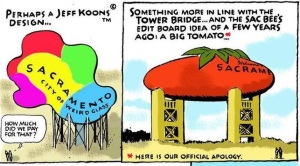For too long, Sacramento has struggled to not just find, but to really celebrate, our identity. We have grappled with an identity crisis. Whether it is our Sac’o Tomatoes cow-town roots or perceptions that we are little more than a pit stop between San Francisco and Tahoe, too often we find ourselves with a chip on our shoulder, trying to keep up with the Joneses but distracting ourselves from the fantastic, unique, comfortable city that we all share. Throughout this series, I use data to explore different aspects of Sacramento to try to help us understand — and celebrate — Who We Are.
In seeking “
to make sure that everyone on Interstate 5 knows that Sacramento is
America’s Farm-to-Fork Capital,”Sacramento’s friendliest water tower has managed to stir up some controversy. It has riled up a number of this author’s neighbors in Nextdoor Pocket and received a
thumbs down from at least one bicyclist. Not surprisingly, Ray Tretheway, the Executive Director of the Tree Foundation
prefers the old version.
“It symbolizes why people think so highly of Sacramento – because of its glorious tree canopy. It’s the best (motto) for today and for the future.” – Ray Tretheway

Our city’s Pulitzer Prize winning political cartoonist, Jack Ohman also
offered a number of colorful alternatives (click the link to see all of them). The
State Hornet even
suggested the tower “can go fork itself.”
Ironically, when the water tower was originally painted in 2003 (at the behest of then Councilman Robbie Waters), the city turned down ideas focused on agriculture to run with the “City of Trees” motto instead. Today, having come to embrace our agricultural heritage, proponents of the change point out that Sacramento is America’s only Farm-To-Fork Capital (most similar cities prefer the term ‘
Farm-to-Table‘) but that it is
one of many that claim the moniker City of Trees.
Sacramento’s urban forest has been recognized as among the
best in the nation and even the world. With 23.6% covered in trees, Sacramento has it made in the shade with the Sacramento Tree Foundation and SMUD encouraging us to do the planting.. Our city was also among the original cities designated as a “
Tree City USA” by the Arbor Day Foundation in 1976. Sacramento State was even named a “
Tree Campus USA.” Clearly, while we are not the only City of Trees, Sacramento is among the very most deserving of the title.


One would hope that Sacramento could be both pro-tree and pro-fork. Celebrating our agricultural and culinary heritage should not have to come at the expense of our urban forest. One wonders if, with a bit more artistic/desktop publishing creativity, both of these identities couldn’t be celebrated side-by-side. Better yet, give the trees back their water tower and create something new to celebrate our beloved tomatoes. Perhaps our city could take inspiration from
Chicago’s cows or
Austin’s guitars and create a public art program celebrating both our love of forks and tomatoes?

We should also take care to frame these conversations and subsequently policies in a way that works to the benefit of the community as a whole. Too often, the immense co-benefits of urban forestry
tend to miss the most at-risk populations. Sacramento is no different. The cities more affluent neighborhoods in
Council Districts 3 (22%), 4 (25%), 5 (19%) and 7 (21%) have high levels of canopy coverage, while more at-risk neighborhoods in District 2 (15%), 6 (14%) and 8 (12%) have more modest canopies. District 1 (5%) may cease to be such an outlier in a few years as its newly planted canopy has time to grow. (Similarly, I would tend to doubt that any more of the benefits of FtF trickle down to the residents who need them most — prove me wrong, advocates, prove me wrong!)



 One would hope that Sacramento could be both pro-tree and pro-fork. Celebrating our agricultural and culinary heritage should not have to come at the expense of our urban forest. One wonders if, with a bit more artistic/desktop publishing creativity, both of these identities couldn’t be celebrated side-by-side. Better yet, give the trees back their water tower and create something new to celebrate our beloved tomatoes. Perhaps our city could take inspiration from
One would hope that Sacramento could be both pro-tree and pro-fork. Celebrating our agricultural and culinary heritage should not have to come at the expense of our urban forest. One wonders if, with a bit more artistic/desktop publishing creativity, both of these identities couldn’t be celebrated side-by-side. Better yet, give the trees back their water tower and create something new to celebrate our beloved tomatoes. Perhaps our city could take inspiration from 
Thaank you for writing this
LikeLike
[…] An excerpt from Sacramentality.Com […]
LikeLike
Great article, thinking the same since the uproar started, celebrate both on the tower!
LikeLiked by 1 person
[…] bureaucracy involved with ensuring our region’s flood safety. Public art, as well, whether a series of tomato on a fork statues or a statue commemorating the sesquicentennial, would be fantastic. I suspect at some point one of […]
LikeLike